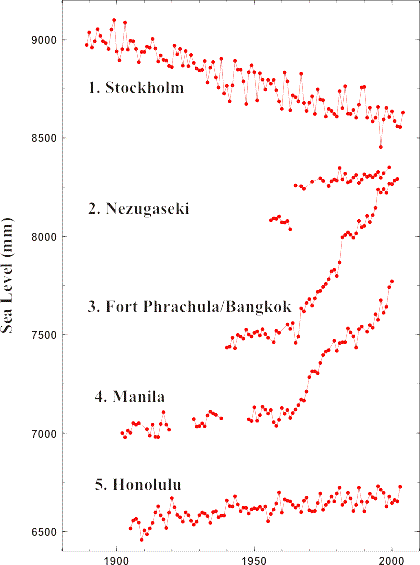
TIGA
Geodetic monitoring of tide gauge benchmarks with GPS

In 2001, the International GPS Service for Geodynamics (IGS, which is today known as the International GNSS Service) established a pilot project called TIGA (the first letters of tide gauge) to meet the needs expressed by researchers from as early as the 1980s, particularly those involved in the GLOSS programme. These needs have evolved with the advent of satellite radar altimétry and the Franco-American mission Topex/Poseidon (1992-2005). They include: the calibration of radar altimeters by tide gauges whose data are expressed in the same geocentric terrestrial reference frame as the radar altimetry satellites using GPS stations; and the continuing need to separate the vertical land movements from the climate contributions of the long term sea-level variations in the tide gauge records. The goal of TIGA is therefore to determine worlwide tide gauge positions and time series of positions with the highest possible quality of metrology and over a long time span in order to deduce the vertical movements of the land on which they are placed along the coast. The image opposite taken from the PSMSL illustrates the variety and amplitude of the land movements that can affect the stability of tide gauges.
The IGS appears to be the appropriate framework to provide the infrastructure in terms of service and research that is required to meet the needs of scientists working on the field of the geodesic determination of the positions and movements of coastal tide gauges on a global and international scale. In particular, it brings together the researchers and engineers of the main Space agencies and bodies involved in the area of GNSS (the Jet Propulsion Laboratory of NASA, ESA, MIT, CNES etc.).
The main components identified in this infrastructure are: (i) operational stations having a co-located tide gauge and GPS; (ii) specialised GPS@TG data centres; (iii) dedicated GPS data analysis centres for tide gauge benchmark fixing and monitoring; and (iv) a centre for verifying, evaluating and combining the results of individual analysis centres (component iii) by cross-comparisons.
Nine years later, the success of the pilot project is such that it has turned into a permanent service (Working Group) of the IGS in 2010.
Further information on the web site of the project (hosted by GFZ, Potsdam).
French participation in TIGA (2001 - 2010)
The University of La Rochelle (ULR), in response to a call for participation, acted as coordinator for a joint proposal with the research teams that were interested. This proposal was reviewed by the experts of the lGS and received a very favourable assessment in November 2001. It related to the first three components of TIGA and today comprises :
– Nine GPS - tide gauge coupled observation stations : Ajaccio (IGN/SHOM), Brest (IGN/SHOM), Dumont d’Urville (ENS/IGN), La Rochelle (ULR/SHOM), Marseille (IGN), Roscoff (ULR/SHOM), Saint Jean-de-Luz (IGN/SHOM), Saint-Malo (ULR/SHOM) and Sète (ULR/SHOM). Other French stations will undoubtedly participate in the future, in particular Papeete, Nouméa and Kerguelen.
– A specialised data centre, which was set up at the University of La Rochelle. It was initially established with the help of the IGN, whose expertise in collecting, exchanging and publishing GPS data is fully acknowledged. The IGN runs one of the four global centres of the IGS, which have been operational since the creation of the IGS in 1992. Today, it is thanks to the support of the University’s Computing Resources Centre that the TIGA data centre can operate. (A "backup" for this centre can be found at CDDIS/NASA, United States).
– An analysis centre for the GPS measurements is a natural addition to the data centre. It was established with the help of the LAREG laboratory of the IGN and is recognised in the international IGS community under the name ULR Consortium or ULR analysis centre. The ULR analysis centre, whose computation facilities are at the University of La Rochelle, today utilizes a cluster of 38 nodes or 392 processor cores. In 2008-2009, equipped with 128 processor cores, the computation time was significantly reduced, from 1 year to 2-3 weeks to process 10 years of GPS observations from a global network of some 200 stations. This opens up new perspectives of experimentation (new strategies, modelling, corrections). In particular, it enabled the ULR group to compete with the 9 most prestigious groups in the spatial field in the first ’reprocessing’ campaign of the international service IGS.
The data centre and analysis centre are global, coping with stations distributed all over the world : data from close to 316 GPS stations are gathered, processed and made available to the international community. This corresponds to the world component of SONEL, which was foreseen at the beginning of the SONEL project, and is today an integral part of it given the international context.
For more information (web site of the TIGA project ).













